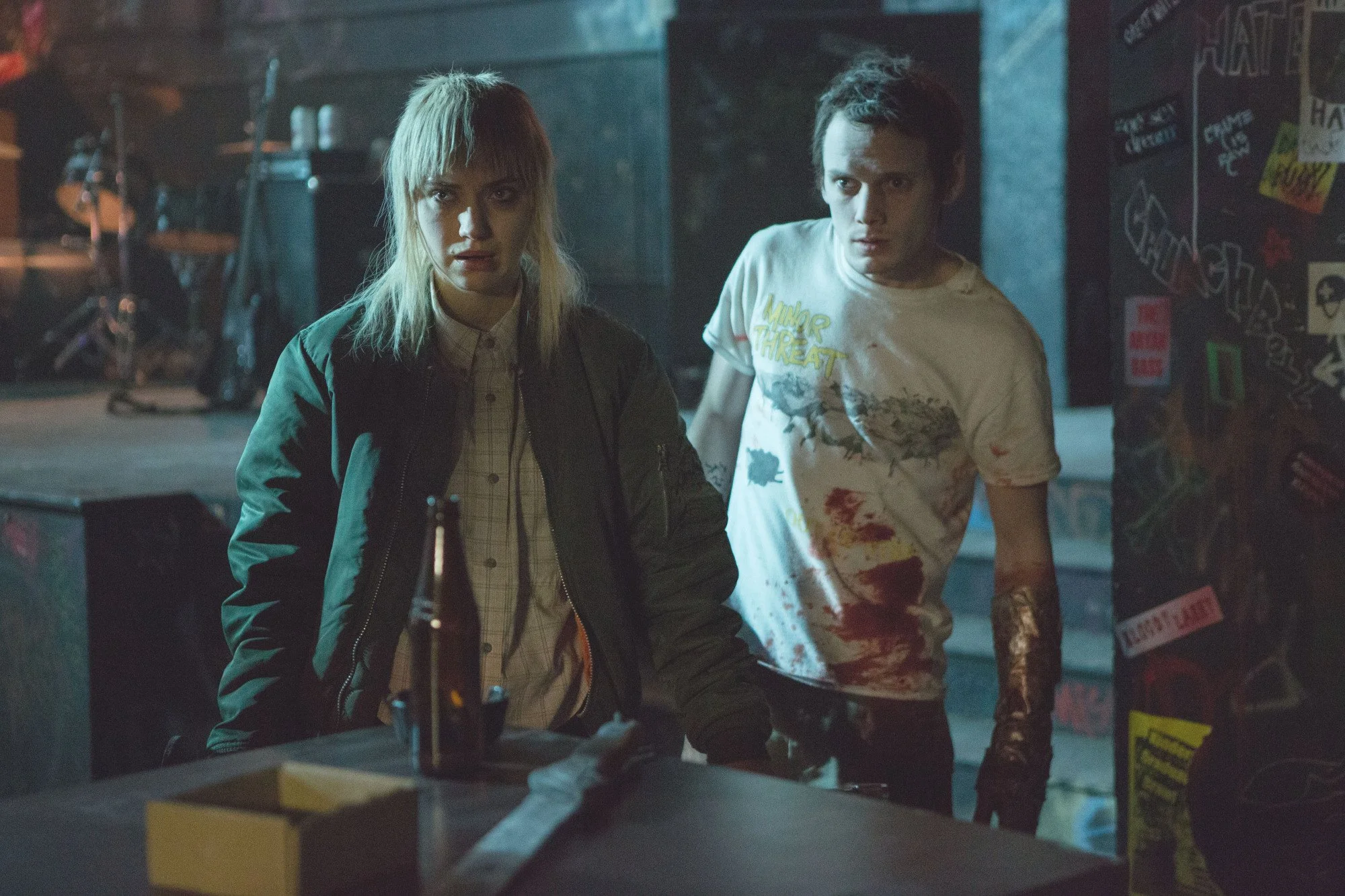Green Room: Revisited
In case you haven’t noticed, Nazism is back. The United States under Donald Trump is stripping rights away and deporting immigrants who've done nothing wrong, except trying to find a better life. Jubilee published a video entitled “1 Progressives vs 20 Far Right Conservatives” and within that twenty was a man who openly embraced being called a Nazi and Fascist. All of this is to say, Jeremy Saulnier’s 2015 horror film Green Room has been rattling around in my brain recently.
Green Room opens with the punk rock band The Ain’t Rights on an unsuccessful tour. The group consists of Pat (the late Anton Yelchin), Sam (Alia Shawkat), Reece (Joe Cole), and Tiger (Callum Turner). Strapped for cash, they agree to play at a Neo-Nazi bar in the Pacific Northwest, run by the sinister yet calmly spoken Darcy (Patrick Stewart). After completing the set, the group are held hostage in the titular green room after falling witness to a murder.
Jeremy Saulnier has made a name in making stylish, efficient thrillers (most recently Netflix’s Rebel Ridge), but Green Room remains some of his finest work. Clocking in at 90 minutes, he doesn’t waste space with exposition. The narrative details are dulled out between exchanges, never drawing too much attention to themselves. Instead, Saulnier prioritizes tension that is broken up by spurts of graphic violence.
Naturally, the film mostly plays out in confined spaces and unlike another thriller Panic Room, Saulnier never affords the audience a sweeping shot where we clock the building’s layout. Once our bandmates, accompanied by Amber (Imogen Poots), adventure out, there is a palpable sense of danger and confusion. The characters don’t know what or who is waiting behind the corner. They don’t know where to escape. This is amplified by the lack of natural light; hallways being lit by fluorescent bulbs.
Part of the tension is rooted in how real the characters come across. A clever detail sprinkled in early on is that Reece is a fighter; “Easy there, Jujitsu,” Tiger says. With some help, he is able to take down the imposing Big Justin (Eric Edelstein) and feels the most comfortable holding a pistol. However, once confronted with real violence, he cannot prevent himself from crumbling. These characters don’t transform into Rambo, painting the walls with the guts of Neo-Nazis. They scatter around and don’t think too far ahead, only finding ways to survive in the moment. And yet, the characters aren’t dumb. When a character gets brutally injured, they’re smart enough to patch them up with duct tape. They use fluorescent tubes and fire extinguishers as weapons. Their key weakness is how unprepared they are for a situation that frankly nobody is prepared for.
Green Room doesn’t flirt with overt politics. Nazism bleeds into the background and is treated as a function of everyday life in the punk scene. When The Ain’t Rights are warned about the venue being populated by “boots and braces,” Tiger says, “Skins? There’s some at every show.” Although, the film does name drop the DMS (Dock Marten Stompers), a non-racist branch of skinheads.
The most Saulnier’s script comes to underlining the Neo-Nazis is at the beginning of The Ain’t Rights set. Pat suggests performing the 1981 Dead Kennedys song “Nazi Punks Fuck Off” as a way to troll the white supremist audience. The action reflects an unspoken attitude our characters have: white supremacy is so accepted, or prevalent, in this community that they don’t fear the repercussions of poking fun. They are woefully unaware of the people they’re dealing with, and what level of brutality these skinheads are willing to participate in.
Darcy makes for a compelling antagonist as the fear he strikes comes from what surrounds him and the fashion he commands. In the article “Green Room and the Frightening Reality of Neo-Nazi Gangs,” author Chris Aitkens goes into the way Darcy, and real Neo-Nazi organizations, build themselves. Aitkens mentions how Darcy probably doesn’t care about the music, but is using it as a recruitment tool: “Aggressive music is a great way to appeal to troubled youth, and holding live concerts with cheap beer gathers them all in one room.”
The troubled youths render themselves as the “red laces” or “true believers.” Young men who've been recruited by Darcy to carry out his vicious duties. Aitkens writes, “On weekdays, Darcy holds workshops on ‘racial advocacy,’ furthering his indoctrination of young minds.” Besides the roles played by Macon Blair and Marc Webber, who are characters that need to stand out, the gang registers as almost faceless; identical young white men with shaved heads. You can’t really tell them apart. That’s the point.
The uniformity of Darcy’s gang is crucial. When you strip someone down and sculpt them into an image that they’re convinced makes them worthy, it makes them easy to control. And in a sense, they became disposable. If one gets killed, another young white man will take their place. Being a part of this army is immensely desirable. Near the end of the film, Macon Blair’s Gabe is offered by Darcy to join the red laces, which he views as a great honor.
Green Room was a more personal film to Saulnier than it seems from the outside. After the indie success of Blue Ruin, a gritty revenge movie also starring Macon Blair, he thought this was his last chance to make a nasty genre film. Also, the idea of setting a film in a green room had been an obsession of his for a while. “I wanted to make a green room movie…When I finally got the chance to do it the right way, I leapt at it. I knew it was my next movie,” Saulnier told Slash Film in 2016.
The idea was rooted in his own experience in the punk scene, including the Neo-Nazis. “[It] was definitely bizarre that people would be out in bright sunlight during a matinee show, proudly wearing swastikas. That element of danger stuck with me,” said Saulnier to Slash Film. He observed that the skinheads “wore uniforms and were easily identifiable. They were like soldiers,” which is reflected in the final film.
When Jeremy Saulnier was making the film, he wasn’t aware of the tidal wave coming. The film premiered in Directors Fortnight at the 2015 Cannes Film Festival about a month before Donald Trump announced his run for President and was released in April 2016, many months before he’d win. Strangely, it was the perfect window of time for Green Room to be made. An element of art is how often work made right before the dam breaks is the art that holds up, not the art made in the midst. Saulnier wasn’t being topical – he was recreating a world he vividly knew.
If you enjoyed this article, please consider becoming a patron of Hyperreal Film Journal for as low as $3 a month!




Hayden Claborn is a film writer based in Austin, TX. He began writing about cinema in high school and was the film critic for his college newspaper. He loves a variety of genres, but his main area of interest is horror films and can talk your ear off about the greatness of Judy Garland. Depending on what day you ask, he’d say his favorite movie is either The Exorcist or The Apartment, with his favorite filmmakers being James Cameron and David Lynch. He goes by He/They pronouns.